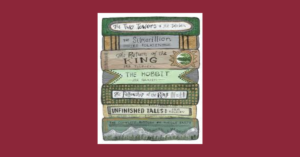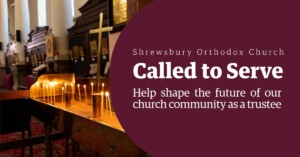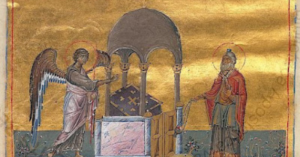Schedule of Services
The schedule of services for this week is available on our calendar. The New Testament readings and sermon for the Sunday of the Prodigal Son are available on the archdiocese website. We will continue to broadcast our services live on mixlr.com when possible.
The church is open for public worship under the guidance issued by our archdiocese.
Gift Aid
Please could those kindly giving in the collection basket please remember to place donations in the Gift Aid envelopes. If you are a UK Tax Payer and you Gift Aid your donation then we can reclaim 20p of Tax that you pay to HMRC back for every pound that you donate.
Appeal from the Shrewsbury Ark
Appeal! The Shrewsbury Ark is requesting food donations that can be made with limited or no cooking equipment. Miso soups, porridge pots, pot noodles, rice pouches etc etc. Please bring with you to church this Sunday.
News and Announcements
- Orthodox Crossing: Bookworming
 Recently my wife Anna took upon herself clerical duties for our church. Good for her as she loves a bit of trouble shooting mixed with a skeleton key for nosing around. It also means that I get to hear about church production motifs and the like, most of which fly a good orbits’ distance over
Recently my wife Anna took upon herself clerical duties for our church. Good for her as she loves a bit of trouble shooting mixed with a skeleton key for nosing around. It also means that I get to hear about church production motifs and the like, most of which fly a good orbits’ distance over - Synaxarion of Our Venerable Mother Winifred, Virgin Martyr and Wonderworker of Wales
 Saint Winifred’s synaxarion for November 3rd: the Welsh virgin martyr restored to life by Saint Beuno, whose miraculous well continues healing today. Continue reading
Saint Winifred’s synaxarion for November 3rd: the Welsh virgin martyr restored to life by Saint Beuno, whose miraculous well continues healing today. Continue reading - An invitation to shape the future of your local church – a call for trustees
 “As each one has received a gift, minister it to one another, as good stewards of the manifold grace of God.” (1 Peter 4:10) Dear Beloved in the Lord, With the blessing of His Eminence Archbishop Nikitas, our first Annual General Meeting as a Charitable Incorporated Organisation will be on 9 November 2025. As we
“As each one has received a gift, minister it to one another, as good stewards of the manifold grace of God.” (1 Peter 4:10) Dear Beloved in the Lord, With the blessing of His Eminence Archbishop Nikitas, our first Annual General Meeting as a Charitable Incorporated Organisation will be on 9 November 2025. As we - Synaxarion for the Conception of the Honourable Prophet, Forerunner and Baptist John
 On the twenty-third of September we celebrate the Conception of the Honorable Prophet, Forerunner and Baptist John VersesThe man received a prophetic oracle from the Archangel,You will beget a Prophet, and even greater than the prophets.On the twenty-third the Forerunner appeared and received the womb. When our Lord and God, the Only-begotten Son and Word
On the twenty-third of September we celebrate the Conception of the Honorable Prophet, Forerunner and Baptist John VersesThe man received a prophetic oracle from the Archangel,You will beget a Prophet, and even greater than the prophets.On the twenty-third the Forerunner appeared and received the womb. When our Lord and God, the Only-begotten Son and Word
Sunday of Orthodoxy
On the First Sunday of Lent we commemorate the triumph of Orthodoxy when icons were restored to the churches after a period of Iconoclasm. It is a good moment to celebrate this while new icons are being painted in our church, particularly the icons of the Empress Theodora and Saint John of Damascus. Saint Theodora is the Empress who stands in the centre of icons of the Sunday of Orthodoxy holding an icon. Saint John of Damascus was the church’s greatest defender of icons.
Homily for the Sunday of Orthodoxy
By Metropolitan Athanasios of Limassol
On the first Sunday of Lent, we celebrate the Sunday of Orthodoxy, that is to say the feast of the restitution of the holy icons, as the Church once again, by the grace of God, vanquished the heresy of the iconoclasts and preserved with exactitude the faith and the tradition of the Holy Fathers of the Church, as it has been preserved throughout the ages.
This faith has as its result the healing of humankind, our salvation and deification. Reverencing the holy icons is proof that we confess that God became a describable person, that the Word of God was truly incarnated and became a person, but also that people truly become children of God and vessels of the Holy Spirit, temples of God and members of Christ. We reverence the holy icons of the Saints and their holy relics because God dwelt in them. So we celebrate the restitution of the holy icons and have the blessed custom of carrying them in procession, of honoring and embracing the icons of Christ and Our Lady and the Saints of the Church.
And since our topic is icons, let’s remember the icon par excellence, the icon of God, the human person. The first to make an icon or image- one of Himself- was God. And this icon is the human person. God said: “Let us make a person in our image and likeness” and, indeed, the human person became an icon of the Triune God, an icon of the invisible God. We can see this image of God. The human person is the most beautiful and lovely of God’s creations. Had God wanted to make something better, He’d have done so. His image, the human person, was the best He made. But this most beautiful icon of God, which had within it all the gifts which God had given it during its creation, was, unfortunately shattered, broken, because the devil was able to smash it.
The iconoclast struggle wasn’t a phenomenon of the 7th century. It began from the first appearance of the human person. The devil instigated a war against God’s icon, against the human person, and managed to shatter it, to make it fall into death, into sin, to make this beautiful image distorted, to the extent that it was no longer testimony to God’s beauty, but instead something which had become ugly, full of passions and sins. But God didn’t wish to see His image languishing in misery, He didn’t want to see His icon, which He had made with so much love and care, become lost in the desolation of the fall and of sin. And so He Himself became human and the model of our salvation. And to help us rediscover the beauty and comeliness of our creation, when we left His hands, He created the Church, through which, first and foremost, He gives the grace of the Holy Spirit. The task of the Holy Spirit is the renewal of our corrupted nature and our rebirth. This rebirth is achieved through two factors. The first is the grace of the Holy Spirit and the second is human freedom. This is how God remakes us. First and foremost through the mystery of the Holy Spirit. When we’re baptized, the great mystery of our remaking is performed; we cast off the old person and put on Christ, the new person. Thereafter, with the power of the Holy Spirit which is given to us through the Holy Chrism, we’re energized and receive strength, so that the gifts we’ve been given through baptism and chrismation can be activated to produce spiritual fruit, to glorify and sanctify us.
On God’s part, everything has been done perfectly and in a manner befitting Him. God has made our salvation and has finished His task; it’s now up to us how we make these gifts our own. People who are baptized in the name of the Holy Trinity, in the Church and through the Church and anointed with the Holy Spirit are thereafter persons reborn in Christ, who can now move forward and activate within themselves the gifts which God has made to them. So we’re all baptized with the grace of God. It matters not whether we’re infants when we’re baptized, because baptism isn’t the result of our own will and our own intellection, but is the result and action of the Holy Spirit. It’s what happens after baptism that requires our cooperation and consent. At the time of baptism, there’s no gift that God doesn’t give us. He regenerates the person in toto, reshapes them and really does clothe them in Christ. And so we begin our struggle, and since God doesn’t act by magic, nor does He eradicate human freedom, this is why our own freedom is needed: to work with the grace of God.
The spiritual struggle we engage in from the time we become aware of ourselves in the course of our lives is precisely how to activate those gifts we received at baptism and which, of course, we have from our creation. It’s because we’re wounded and in thrall to sin that baptism’s necessary for us and why Christ was adamant: “everyone who believes and is baptized will be saved”, because baptism is necessary, together with faith, for us to be saved, since without them we can’t be reborn.
And so the struggle begins and it’s the struggle against iconoclasm. It’s a struggle of Satan, of the sin of our environment, of ourselves against the image of God, against the icon we bear within ourselves. How will the devil shatter the image of God we have both by our nature and from our baptism? Sin is what destroys the image; that’s what sullies the image and mars it, which makes people fragmented and unable to function naturally, as God made us. Sin is essentially captivity, it aims directly at our freedom and kills it, which is why it’s an insult to God and to the person. People who are subject to sin don’t have freedom. At every point where we’re defeated by sin, that’s where we’re slaves of sin. After that, the love that we had because we were made in the image of God, which was directed to God and through God to the world and creation and to our fellow human beings, becomes a passionate love, idolatrous and corrupt. As regards the creation, it becomes idolatry and as regards the passions it turns to sensuality, ambition and avarice. The person, who was so beautiful, as made by God and, above all, free, is now a slave and captive in these bonds.
Although we’re baptized and sealed with the Holy Spirit, though we have within us the seeds of the beauty of God, we still have to provide our own co-operation in order to germinate all these seeds.
How can people remake this image of God and see the great beauty they possess by nature, by their very creation? This is why this spiritual struggle on the part of the Church is so significant, because we know that the aim of the struggle is to restore the icon of God which has been shattered. Particularly at this period, the Church mobilizes all its forces to help each of us to complete our own struggle and aim. The Church has spiritual weapons and medicines, because it’s a spiritual surgery; it has the equipment to rid the body and soul of disease and knows how to give people their health. So fasting, prayer, vigil, almsgiving, confession, participation in the sacraments, the Divine Eucharist, everything the Church offers are the medication that destroys evil.
The presence of God in the Church reworks our image for us and we really do become as God made us, image and likeness. This takes place when a person enters the realm of grace. And the people who succeed are those who find the key to enter the Kingdom of Heaven, people who’ve learned repentance, who’ve been able to change their way of thinking and have humbled themselves. Let us keep this icon of God before us and fight against the iconoclasm of the devil, who wishes to break the image of God with which we were clad at our Holy Baptism.
Source: The periodical Παράκληση of the Holy Metropolis of Limassol, Cyprus.